Media | Articles
Why on earth is an IROC Camaro worth more than a C4 Corvette?
There’s a certain order of things in the car industry. Some brands and badges just sit higher up on the totem pole of price than others. A Lincoln is more expensive than a Ford, a Lexus more expensive than a Toyota, a 5 Series than a 3 Series, etc. Convention also dictates that a Corvette is supposed to be pricier than a Camaro.
That’s certainly the case when shopping for new cars in 2022, and it was the case in 2012, 2002, 1992 and way on back. If Chevrolet’s pony car is the working man’s whip, America’s sports car is what the owner of the company he works for drives. If the Camaro is attainable, the Corvette is aspirational. You get the idea.
So what?
When going over our quarterly updates to the Hagerty Price Guide recently, we realized the status quo has been upset for a certain Chevy performance pair, specifically from those mustachioed muscle years of the 1980s.
Not only is a Camaro IROC-Z (1985–90) worth more than the equivalent base C4 Corvette (1984–96), it’s worth a lot more. More than twice as much, actually, and this reversal of things predates both the recent boom in interest for all things ’80s cars and ’80s revival events like Radwood.
Marketplace
Buy and sell classics with confidence
We have a major market anomaly on our hands, then. The situation is sort of like booking a guided African safari for cheaper than a trip to the local zoo, or eating at a restaurant whose steak is cheaper than the burger. To try and understand this contradiction, we found a pair of these star-spangled mullet-mobiles—Sajeev Mehta’s 1985 Corvette and Kay Yasoni’s 1988 Camaro IROC-Z —for a back-to-back drive on a (finally) cool fall morning in Houston, Texas.
We wanted to find out if, perhaps, modern car collectors are on to something that wasn’t obvious to General Motors product planners in the 1980s.
That wouldn’t be unheard of. Some of the hottest cars on the market were, at one point, thought to be attainable or less. A Mini Cooper from the 1960s can easily be worth as much or more than some contemporary Rolls-Royces; a Mazda MX-5 Miata can easily bring more money than contemporary Cadillacs and Lincolns—and that kind of makes sense.
This sort of thing happens all the time in other markets. Vincent Van Gogh died a failure. Now his works are priceless.
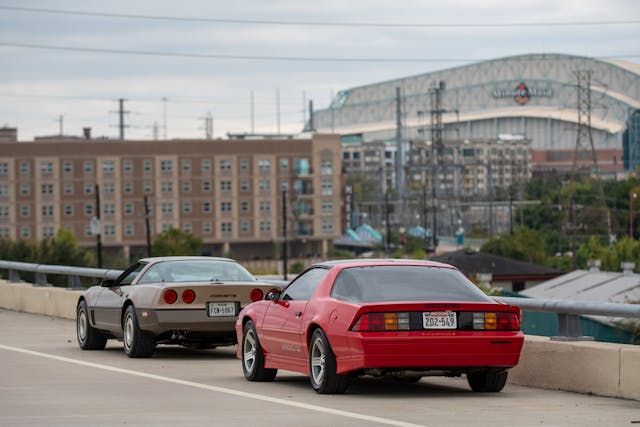
Debuting in 1982 and 1984, respectively, the third-gen Camaro and the fourth-gen Corvette were the right cars at the right time for General Motors. Both of their predecessors were long-in-the-tooth and near-caricatures of their former selves by the early ’80s. Thanks to computer-aided design, fuel injection and more sophisticated suspension, the General finally pulled these American sports cars out of the malaise era.
“We needed to get the Corvette back to the performance level of 1970,” said Dave McLellan, the Corvette’s chief engineer during the C4 years. Chevy mostly pulled it off, with Car and Driver calling the first all-new Corvette in 20 years “a true-born, world-class sports car loaded with technical sophistication.”
The Camaro, meanwhile, was another breath of fresh air that brought a completely new look to Chevy’s pony car, leading Motor Trend to award it Car of the Year honors for 1982.
The Z28 was the speediest Camaro upon the third gen’s debut in 1982, but from 1985 to ’90 the top dog in the lineup was the IROC-Z Sport Equipment package, often shortened by funny-haired gearheads everywhere to simply “IROC.”
The $659 option took its name from the International Race of Champions, a race series pitting the stars of NASCAR, Indy, and sports car racing against each other in identical Chevy Camaros.
The actual IROC race cars weren’t much more than Camaro-shaped shells on top of a NASCAR tube chassis. But, like any good car company, Chevrolet was never one to miss a marketing opportunity and slapped IROC decals and a body kit on its latest flagship Camaro. Uprated suspension, bigger sway bars, upgraded wheels and tires, fog lights, and a choice of V-8 engines came with the stickers.
For the second half of the 1980s, the IROC was the Camaro to have, with the most power and, of course, the most flash.
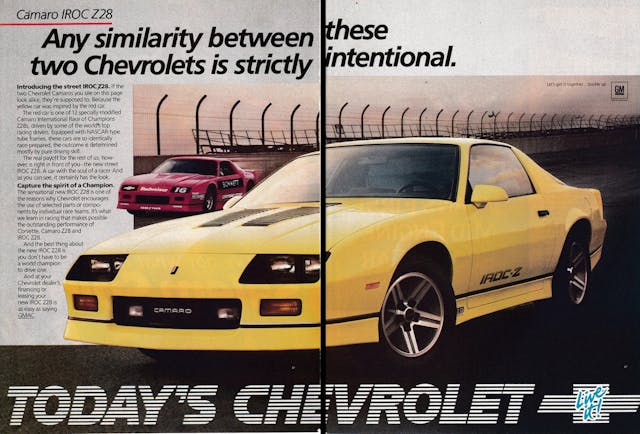
For 1988, Chevrolet slimmed down the Camaro lineup by dropping the LT and Z28 models, leaving only the base coupe and the IROC-Z. Although a taller final drive was paired with the 350 engine, its output kept rising, up to 245 horses for 1990. The International Race of Champions series began using Dodge Daytonas in the ’90 season, so Chevy dropped the IROC-Z package in 1991, reinstating the Z28 as the range-topper.
Owner Kay Yasoni’s IROC is a bone-stock, Bright Red ’88 model with the desirable L98 350 and T-tops, and it has gotten the kind of restoration work normally seen on older, more valuable pony cars. Maybe it’s the color, or maybe it’s because I haven’t seen such a clean third-gen Camaro in 20 years, but this car looks fantastic, even next to the Corvette that was supposed to be the premium offering. Its wedgey angles have aged well.
The inside is straightforward ’80s GM (plastic, lots of plastic) with gray cloth seats and right angles everywhere with square vents, stereo, and switchgear. The only things that are round, other than the leather-wrapped steering wheel, are the simple gauges—speedo on the left, tach on the right, and auxiliary readouts in the middle. It’s more restrained than one might expect for a decal-laden performance car named after a race series, but it is functional.

Easy-to-remove glass T-tops offer a clear view of the sky above, and aside from a hint of red fenders and hood vents, there’s a panoramic view of the road ahead as well. I may have forgotten my Whitesnake cassette, but it turns out I didn’t need it—driving this IROC turns back the clock plenty.
As a performance car, the IROC both then and now leaves something to be desired. As a time machine, though, it’s hard to beat. It’s a fun car that people fall in love with it because it brings back memories and feels very of-its-era.

The crisp body produced 24 percent less drag than the C3, the rear hatch offered more space for luggage, and the clamshell hood offered more room to service the engine. A “uniframe” chassis combined a traditional rail frame with separate frames for the windshield and B-pillar. A removable targa roof bolted in between the A- and B-pillars.
Front A-arms and spindles were computer-designed and for the first time and made from forged aluminum, while the compact multilink rear suspension sported a transverse fiberglass leaf spring. An all-digital instrument cluster gave off Tron vibes in a time when most cars had only recently gotten an itty-bitty digital clock.
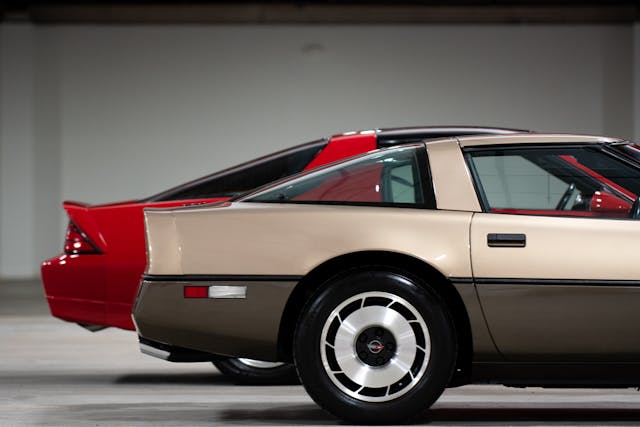
Despite that, initial reviews complained of the new Vette’s jarring ride as well as incessant creaking and rattling from the plasticky cabin. GM improved the ’85 Corvette’s ride with softer spring rates, while the 350 cubic-inch, 230-hp L98 engine debuted under the hood. The workhorse L98 would power the base Corvette until it was replaced by the 300-hp LT1 in 1992. Transmissions were still either automatic or, from 1984-88, a “4+3” manual built by Doug Nash that was essentially a traditional four-speed with overdrive on the top three gears.
And even though the IROC has a racy name, the Corvette wouldn’t be America’s sports car without some motorsports history of its own to back up those crossed flags on the hood.
In SCCA Showroom Stock GT racing, C4s swept the Playboy and then Escort Endurance Championship from 1985–87, and there was nothing the Porsche 944 Turbos could do to stop them. So dominant were the Corvettes that they were booted into the single-marque Corvette Challenge series.
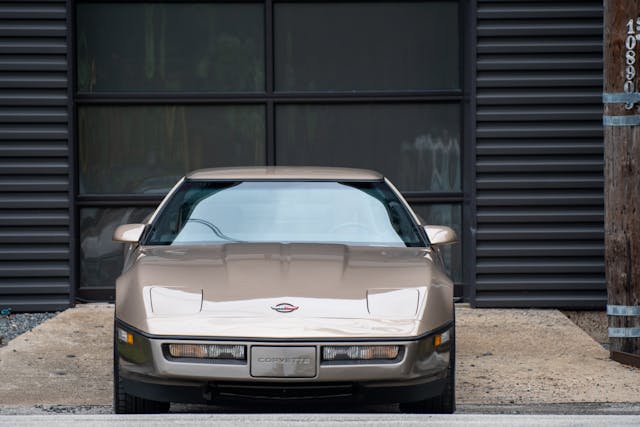
The enormous door sills make getting in and out of a C4 a challenge for anyone, least of all for the 50-somethings who typically buy Corvettes. They say you shouldn’t wear a skirt when driving one of these cars, but it’s awkward no matter what you’re wearing.
If the Camaro’s interior is a cabin, the C4’s is a cockpit. A slightly cramped one that nestles you in between the aforementioned sill and an equally tall transmission tunnel, the green and orange glow of that arcade-game instrument cluster greeting you from behind the two-spoke steering wheel.
If squeaks and rattles were standard factory equipment on the C4, as the old joke goes, they left them out when building this one. It was no noisier than the Camaro. We didn’t take the roof off, though, which in a C4 allows the body to flex and creak through corners and over bumps.
Even with the roof on, a C4 lumbers and rolls through corners more than one might expect, feeling planted but certainly not light on its feet. Step on the go-pedal, though, and the car livens up, feeling as though its 230-horse, 330 lb-ft torque ratings are delivering more than what the digital speedometer is reading (a hybrid-analog-digital dash arrived in 1990; dim or failing gauges are common on the earlier cars).
These two bowties weigh within a hundred pounds of each other and share the L98 engine, but the Corvette feels considerably quicker.
When the ’80s kitsch falls away, you’re left with a more purposeful sports car than the contemporary Camaro. The Corvette is lower, quicker, more exciting. It’s a more entertaining experience behind the wheel whether you’re driving it or sitting in traffic. Even the interior’s gimmicks and eccentricities lend a sense of occasion missing in the IROC’s sea of plastic.
Of course, this is as it should be. The Corvette was then, as now, GM’s performance flagship and cost more than even a loaded IROC when new (an IROC could get to $20K with options, but the ’85 Corvette started at $24K).
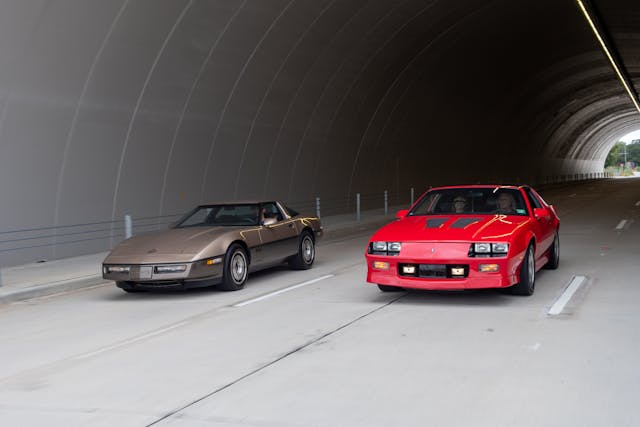
Why are low-mile IROCs storming through Bring a Trailer for prices over $40,000 and even $60,000 while base C4s in similar condition are lucky to sell in the 20s?
There isn’t one big answer, but there may be a few smaller ones. One is the rarity of good-condition IROCs. Chevrolet sold third-gen Camaros by the lot, but IROCs were expensive. Kay’s red coupe is one of 24,050 IROC-Zs sold in 1988, but only about half of that number came with the big engine.
Also, many IROCs lived hard, well-used lives, and as they aged they were frequently left to the elements. Meanwhile, Sajeev’s C4 is one of nearly 40,000 Corvettes sold for ’85, and if the typical IROC buyer was out looking for a stop light drag, the Corvette owner was a middle-aged family man who only drove it on the weekends. As such, the C4 survival rate is higher, the typical mileage lower.
There’s also the fact that while the IROC-Z is top dog among third-gen Camaros, an early C4 has to look at the taillights of Callaways, ZR-1s, Grand Sports, and even later base cars. Mehta’s bronze beauty is a very nice car, but it’s no “King of the Hill” ZR-1 (although even ZR-1s remain relatively affordable).
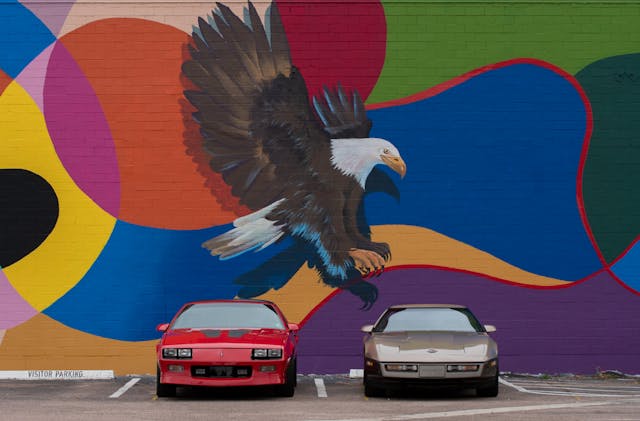
Meanwhile, Gen Xers apparently go gaga for third-gen Camaros. Although Gen Xers make up 32 percent of the market as a whole, they own about half of the IROCs insured with Hagerty. IROC values started to soar in 2014, about when this generation of enthusiasts entered their high-earning, mid-life, fun-car-buying years. That’s probably not a coincidence.
Last but not least, there are impossible-to quantify matters of perspective. Even with the old jokes about mullet-wearing owners, these Camaros really play to nostalgia—a powerful force in any collector market. For those of a certain age, the IROC was the attainable car they dreamed of—the car the coolest kid in your high school might have driven. The C4 Corvette, rightly or wrongly, may be remembered as something your buddy’s dad drove, probably while wearing New Balances and high socks.
Even the C4’s technological advancements might work against it in the minds of collectors. It hails from an era when General Motors squandered a fortune on technical solutions, from paint-shop robots that wound up spraying each other to plastic-bodied compact cars that couldn’t match the refinement of contemporary Hondas. It’s also sort of stuck in a middle ground where it’s too new and electronic to really be considered a “classic” in the sense of a C3, but at the same time it lives in the shadow of the much faster (and today not much pricier) C5.
I still don’t get it, though. The massive gulf in value between these cars that used to share showroom space is just too big to make sense, and if one is undervalued, maybe the other is overvalued. Either way, it’s yet another case of why the car hobby is not always a rational one.
Check out the Hagerty Media homepage so you don’t miss a single story, or better yet, bookmark it.

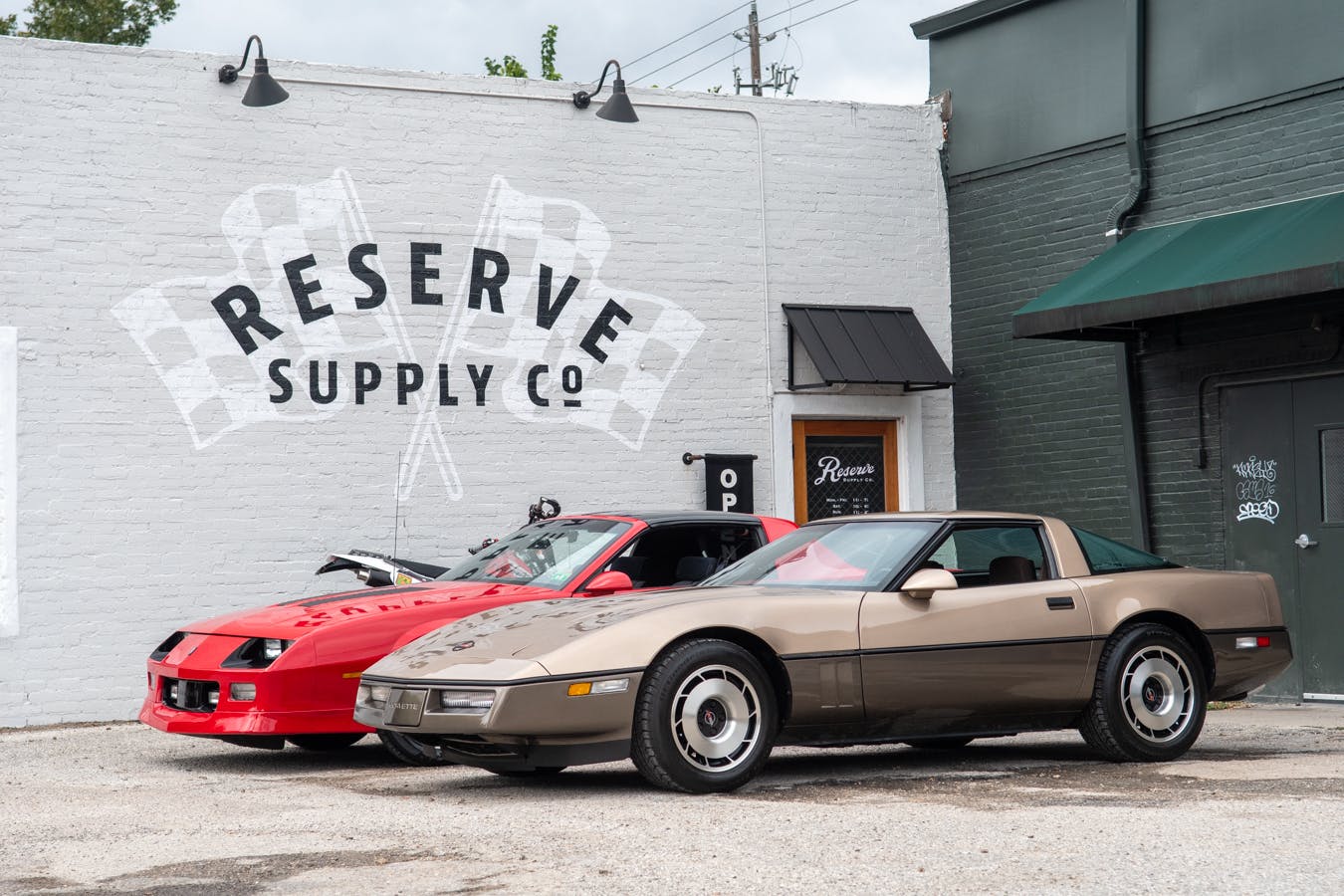
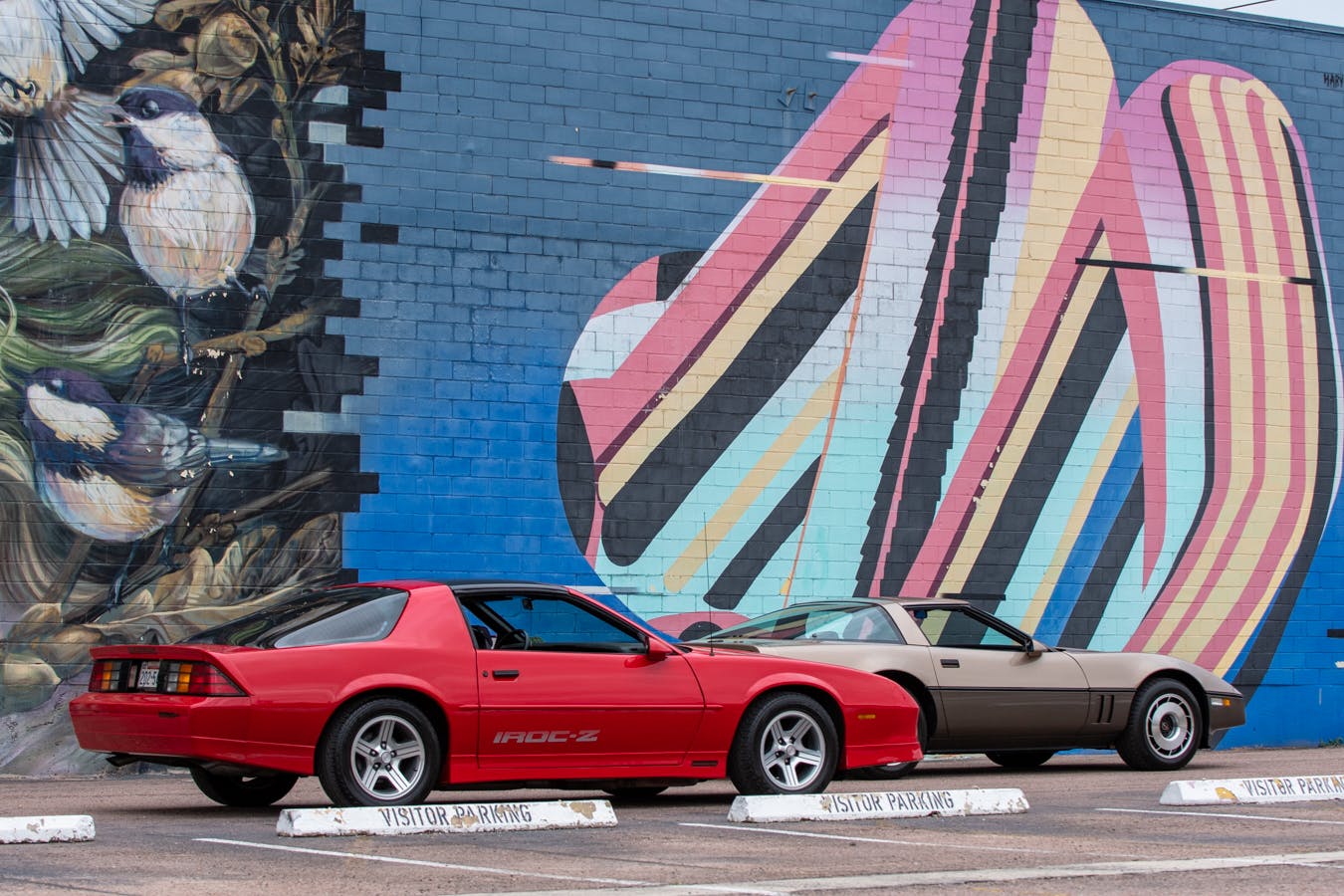

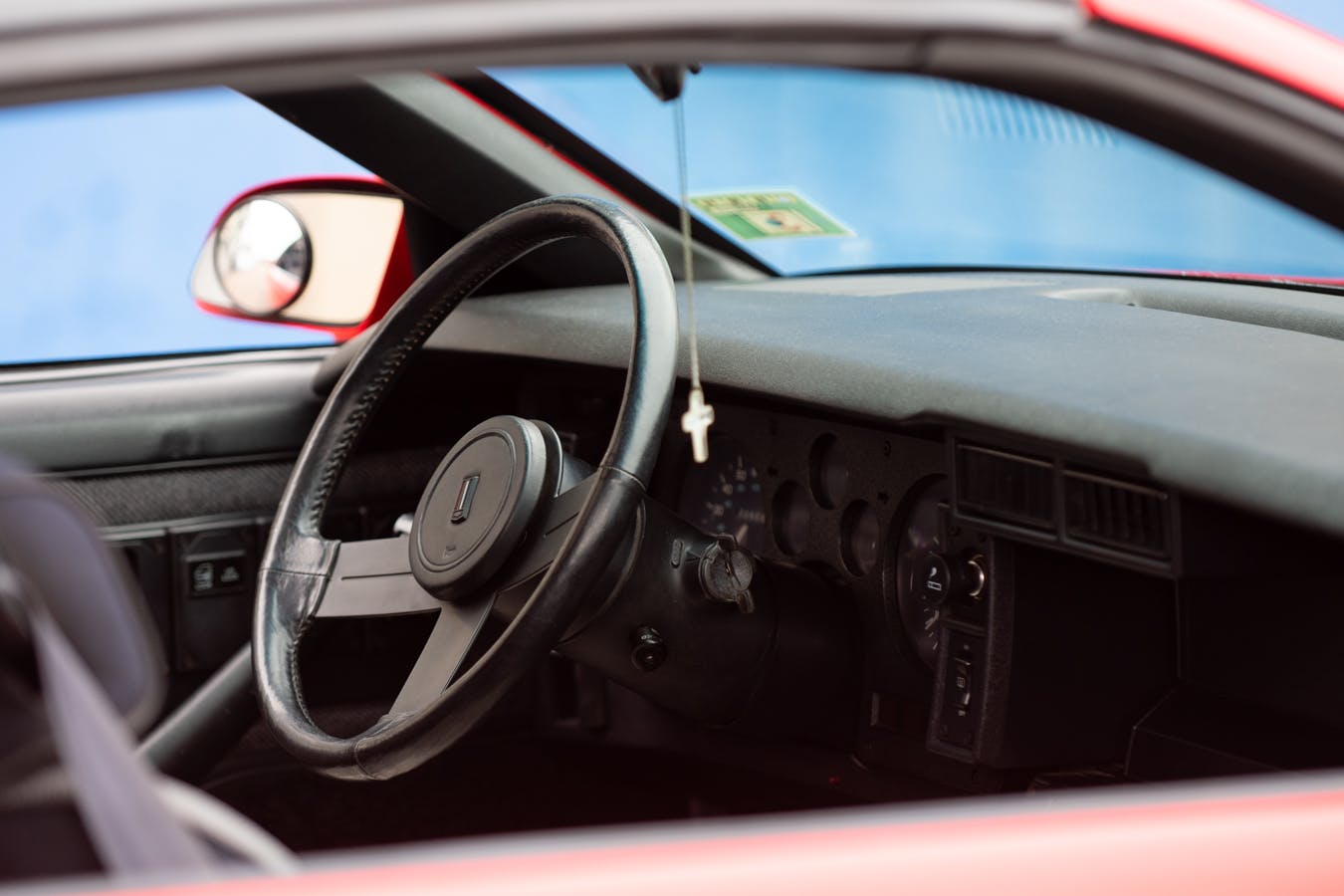
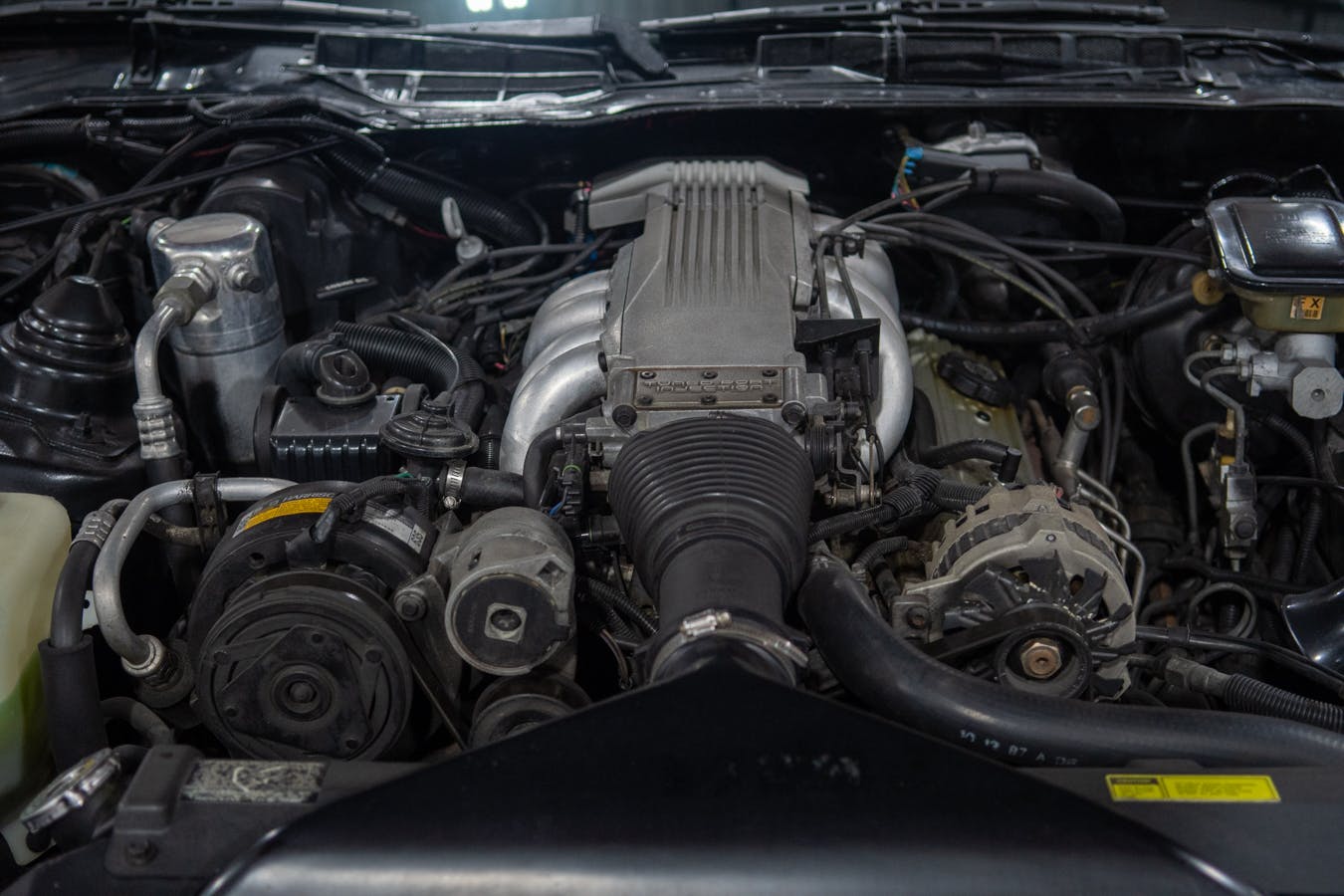
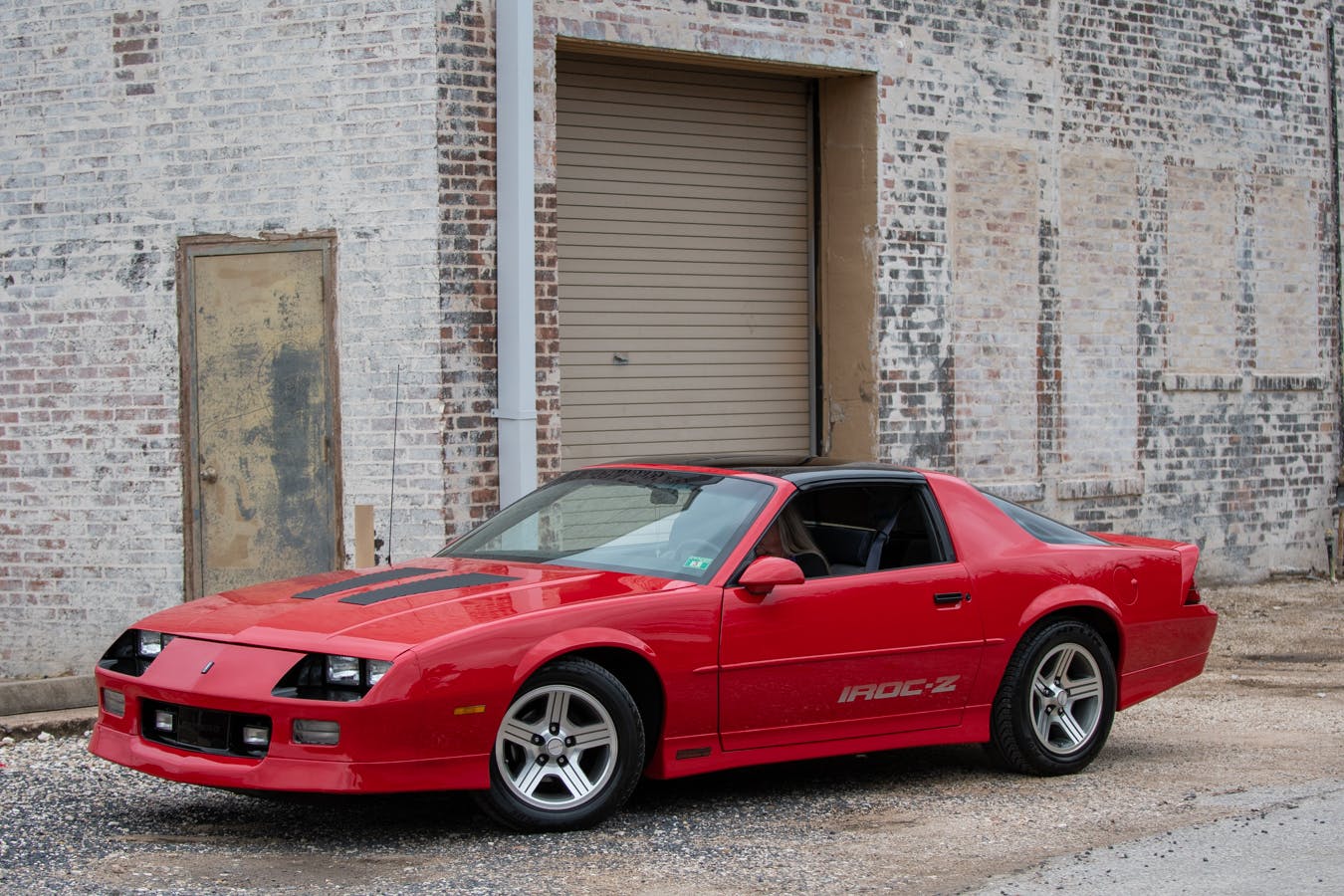
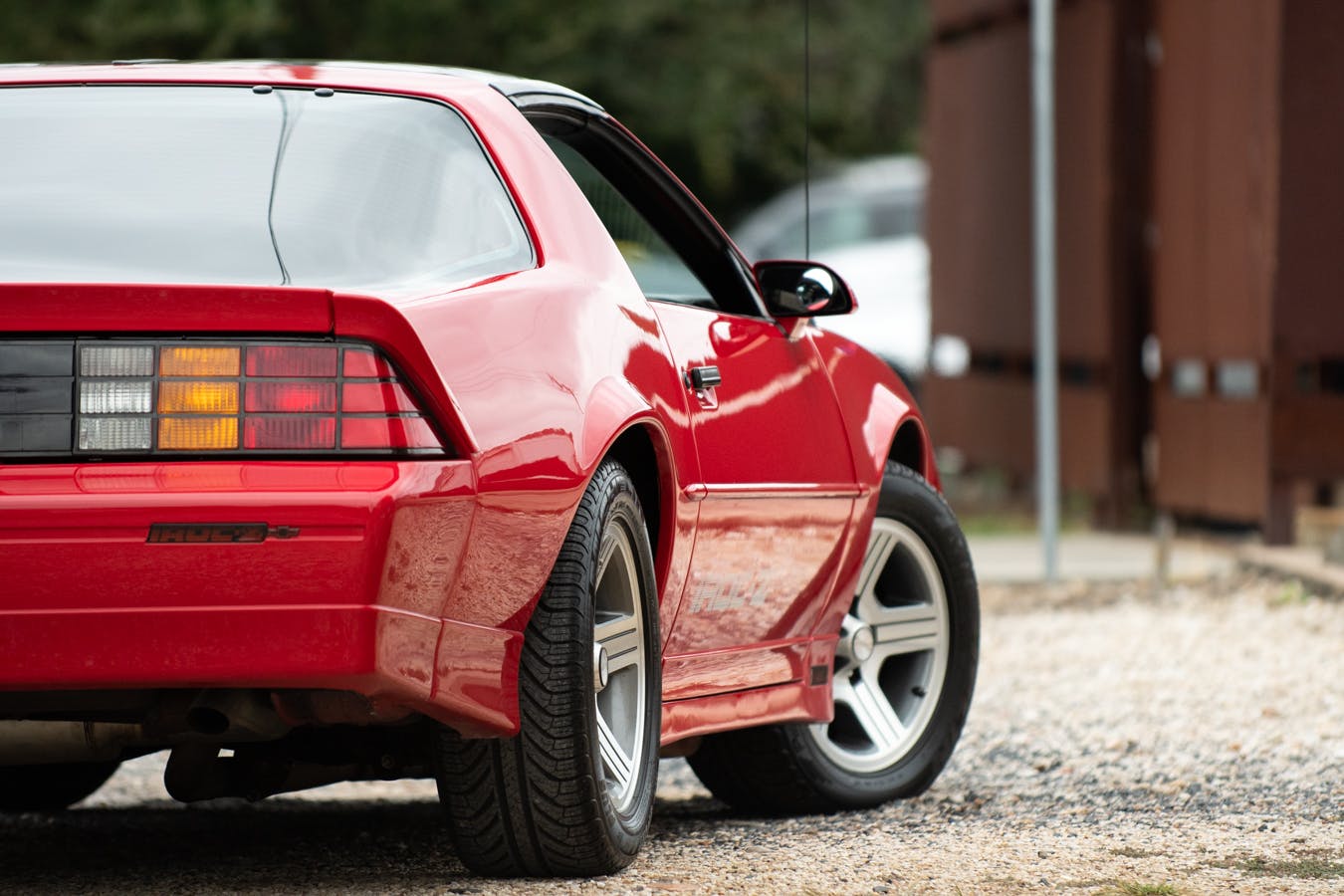


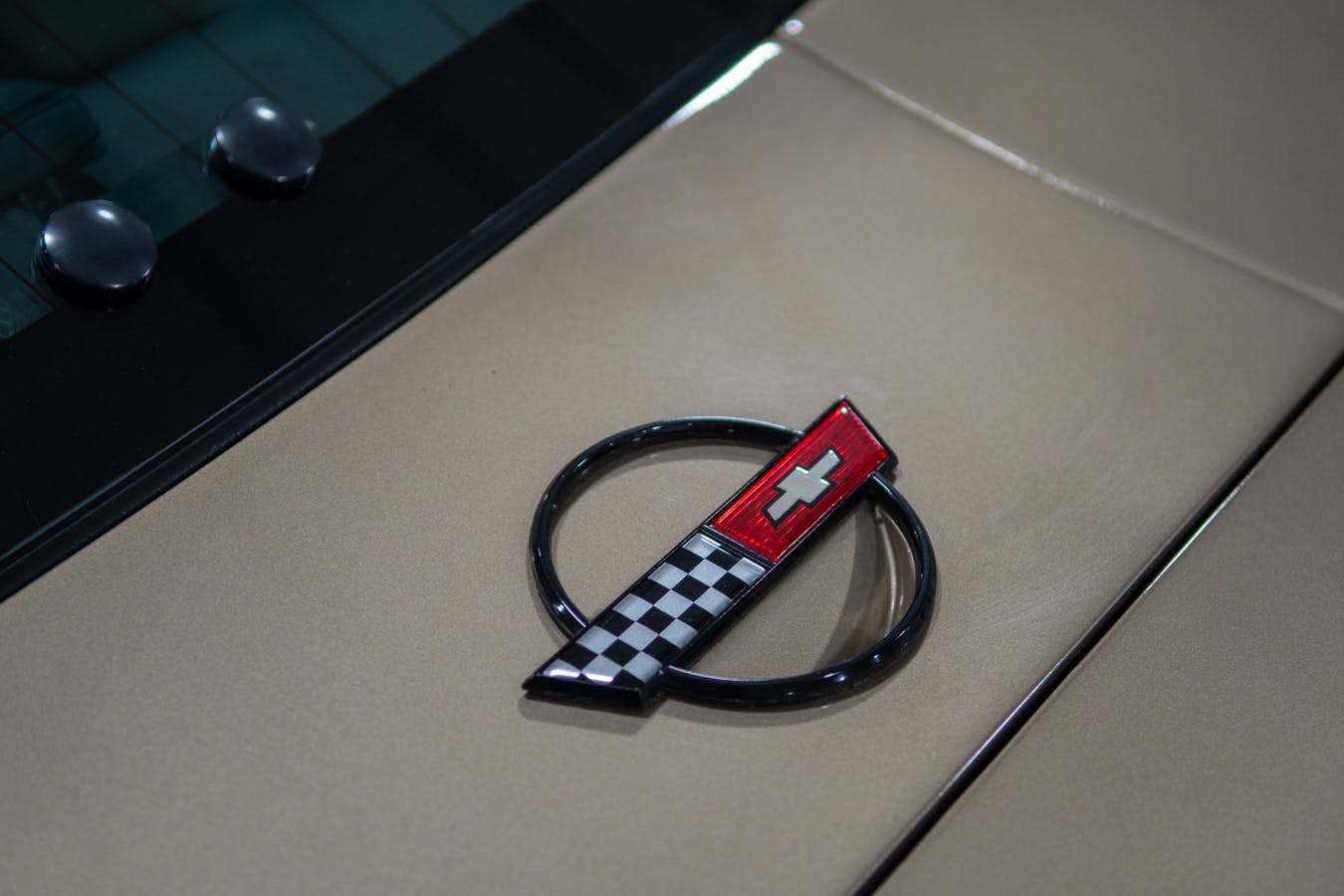
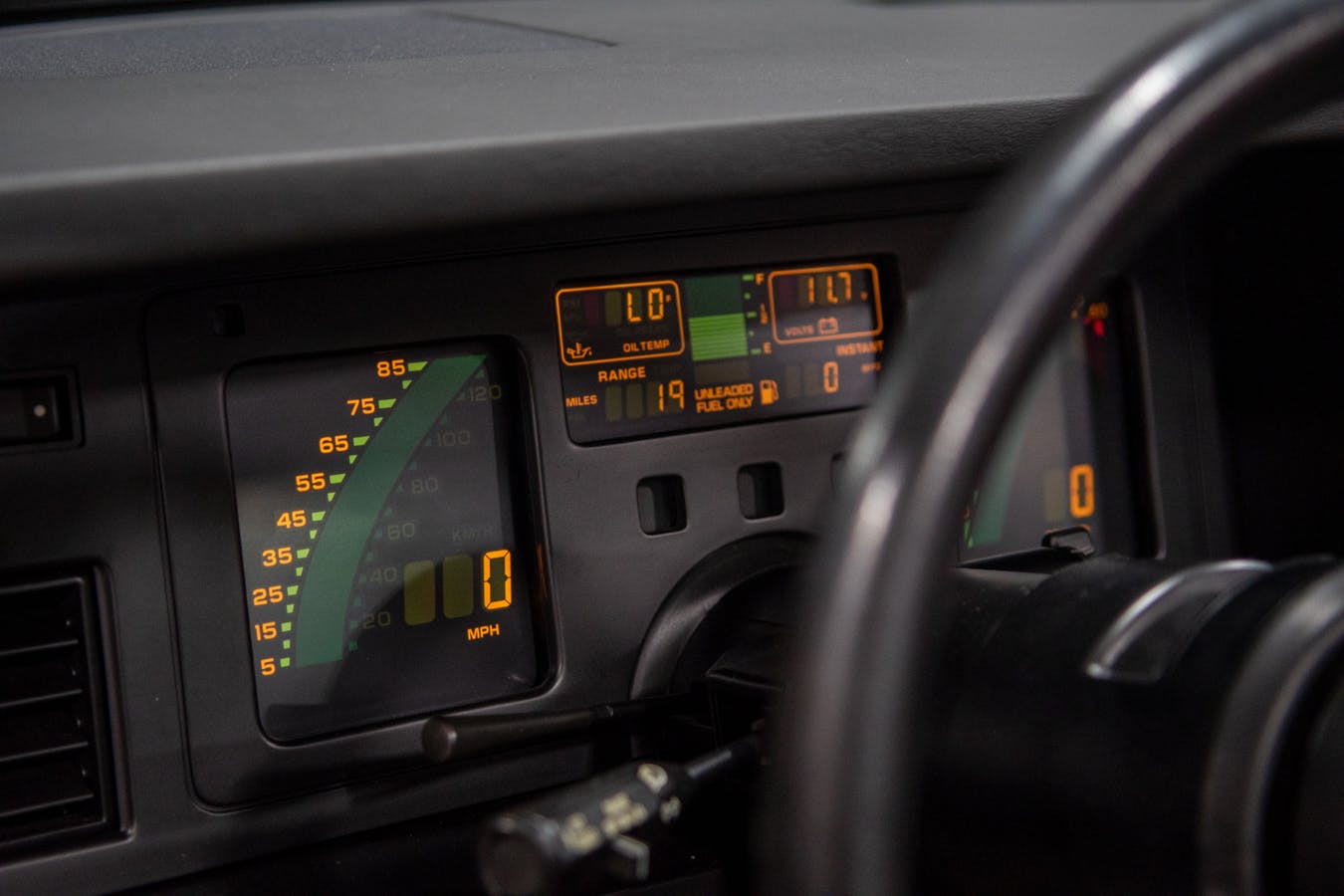
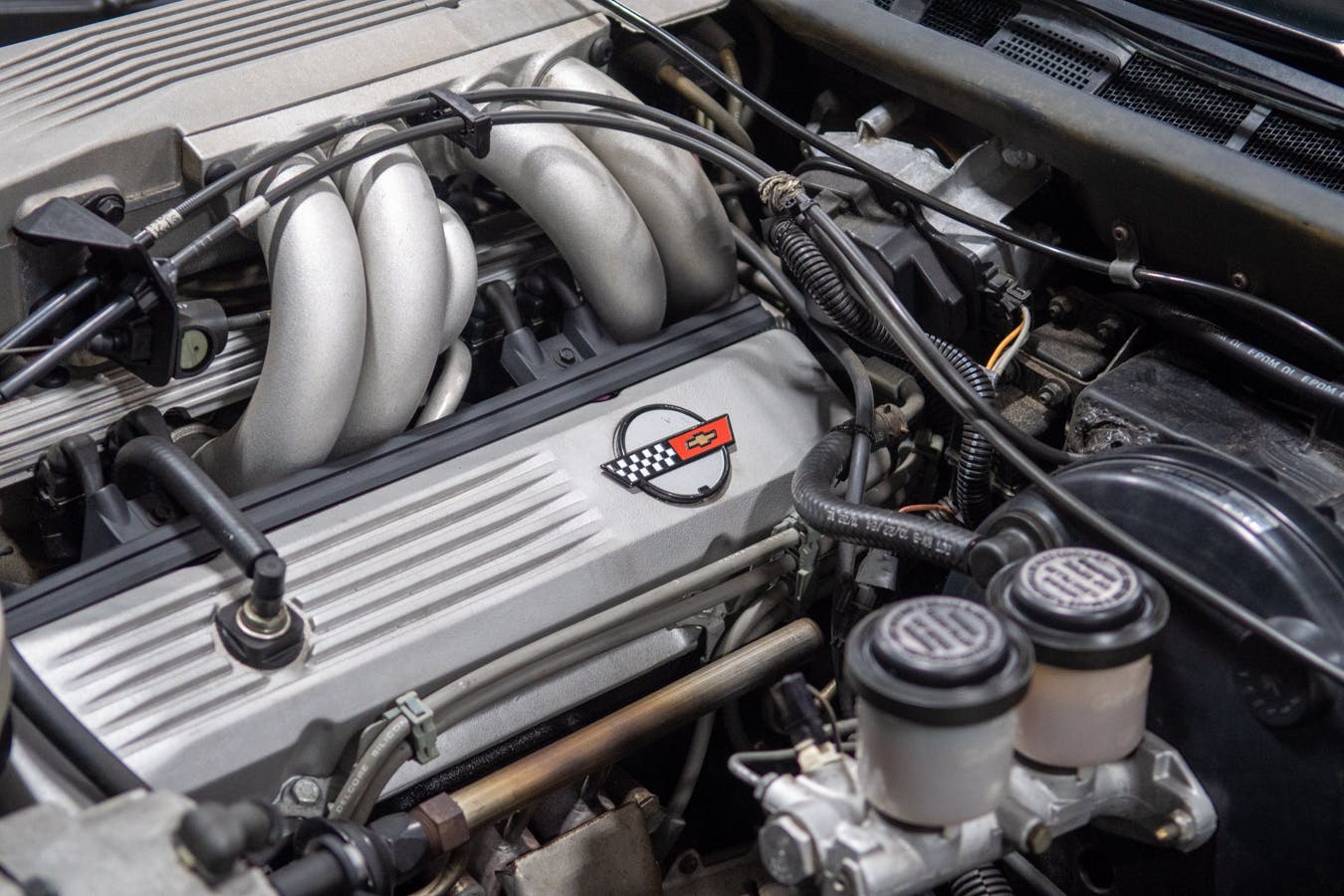
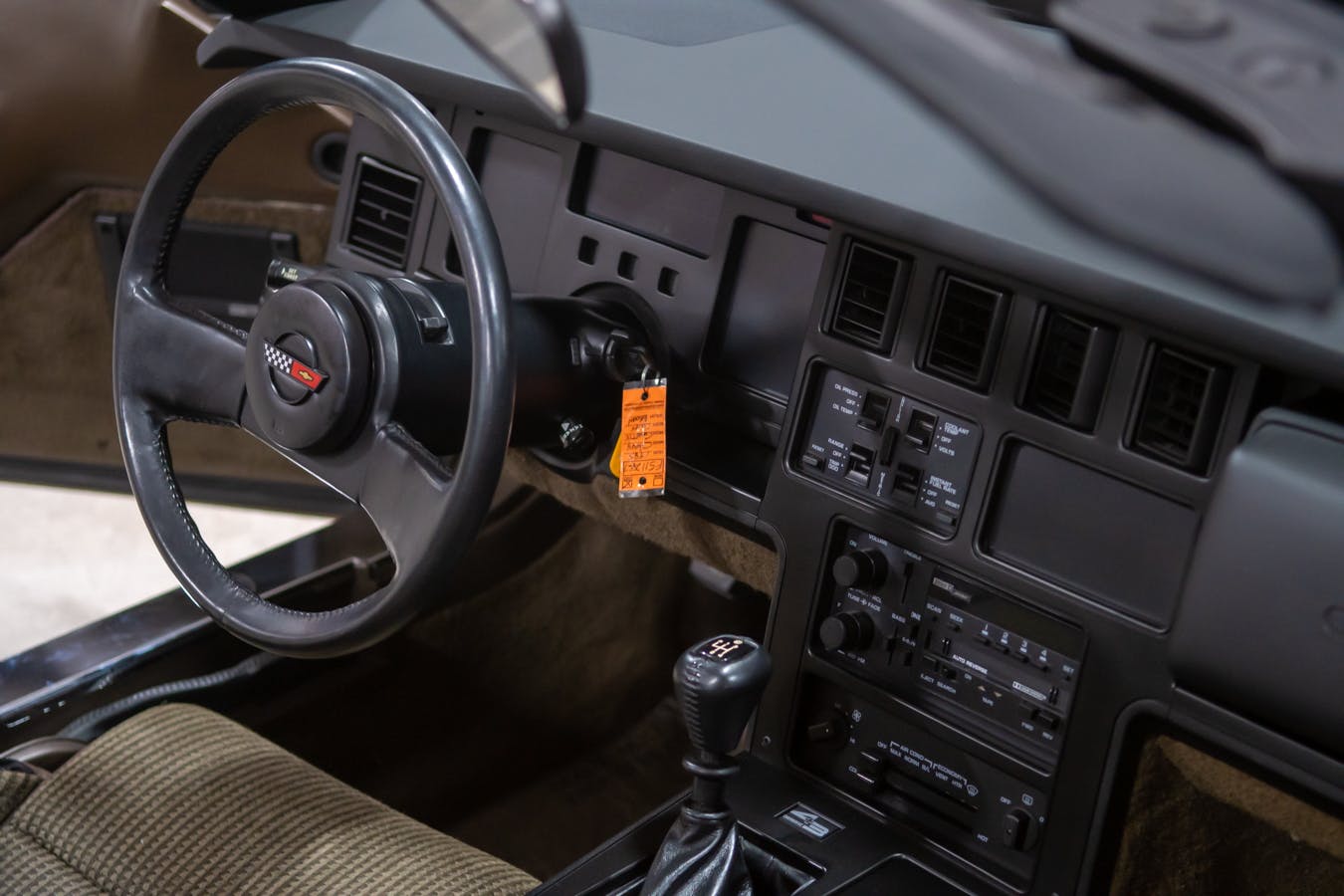
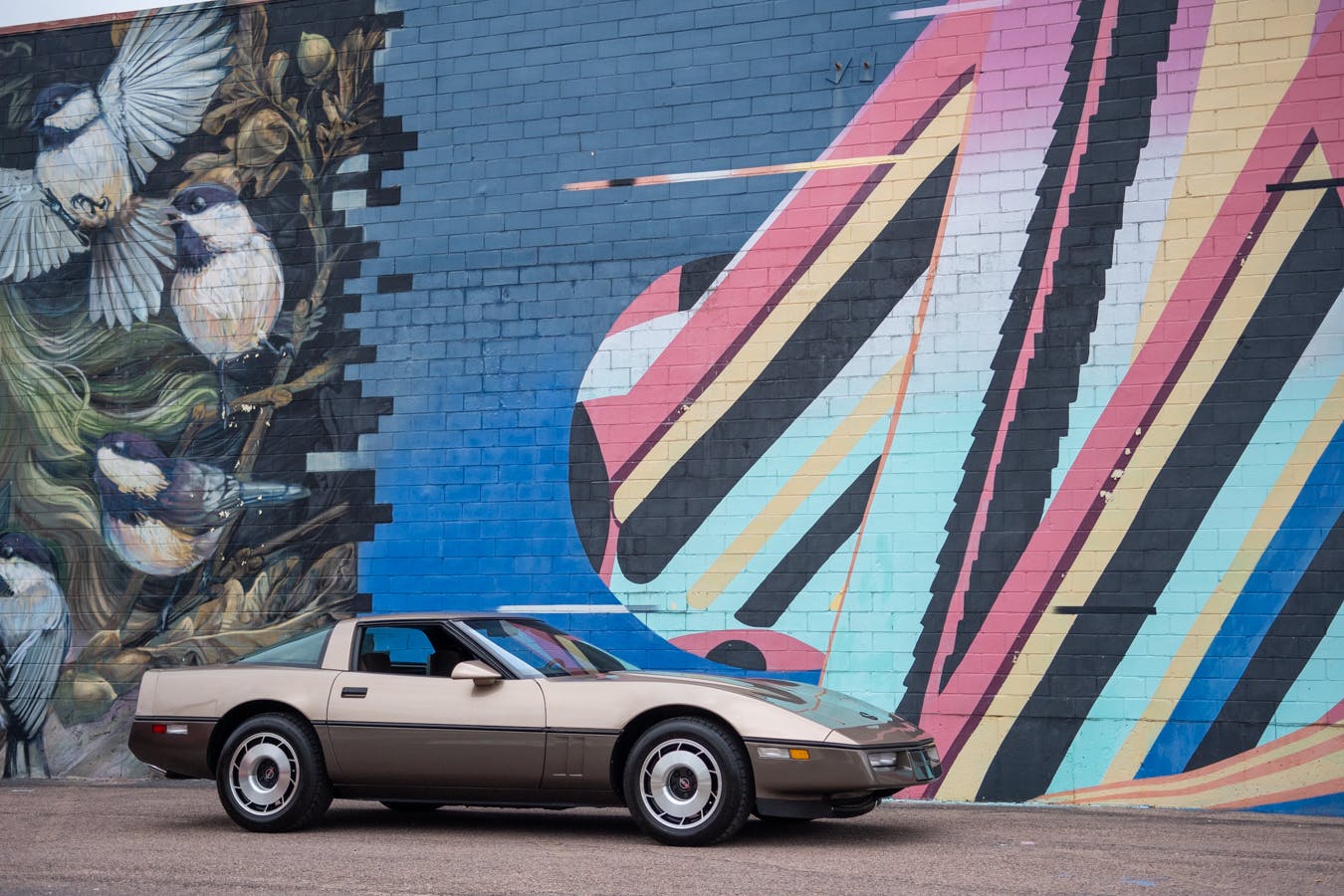
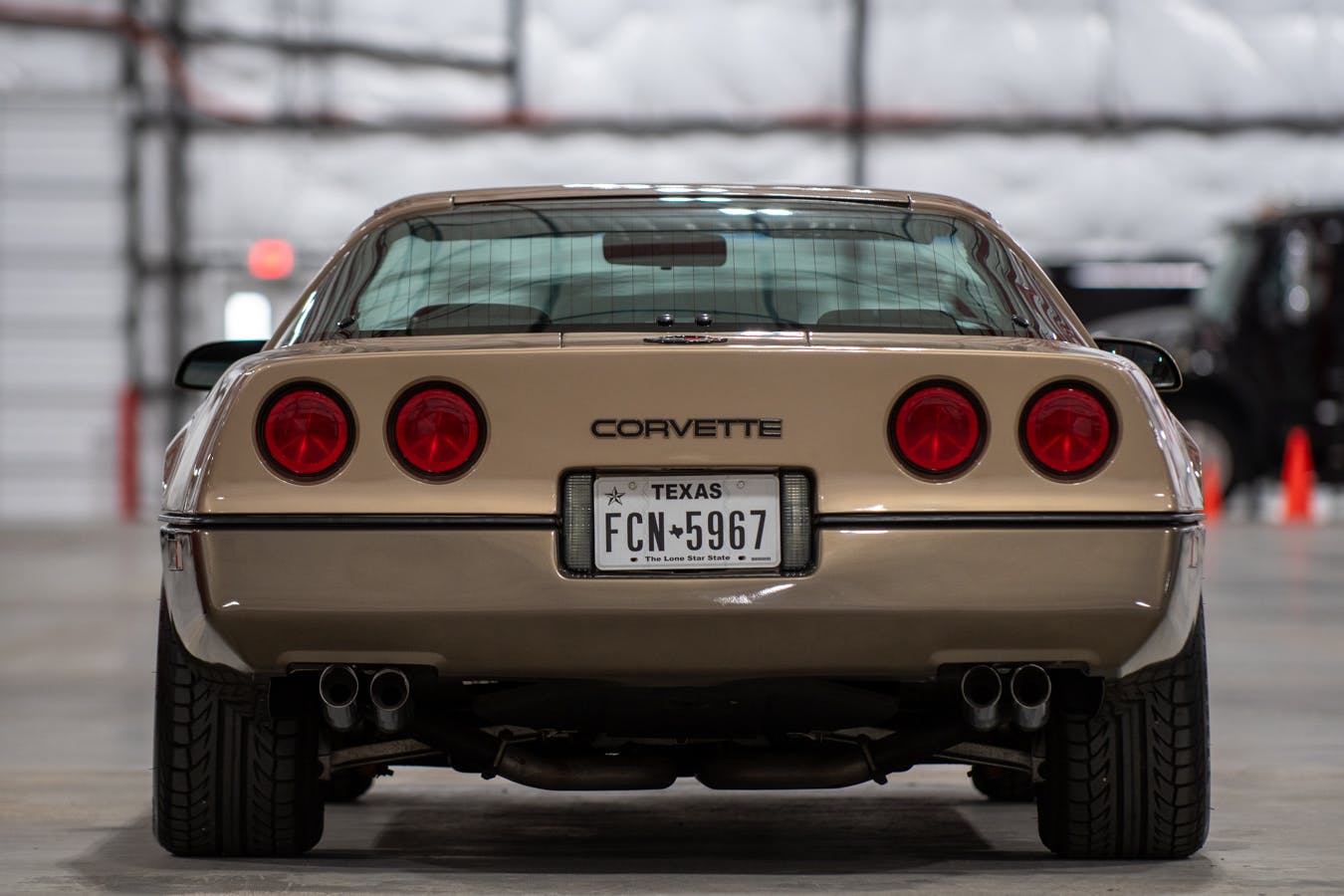
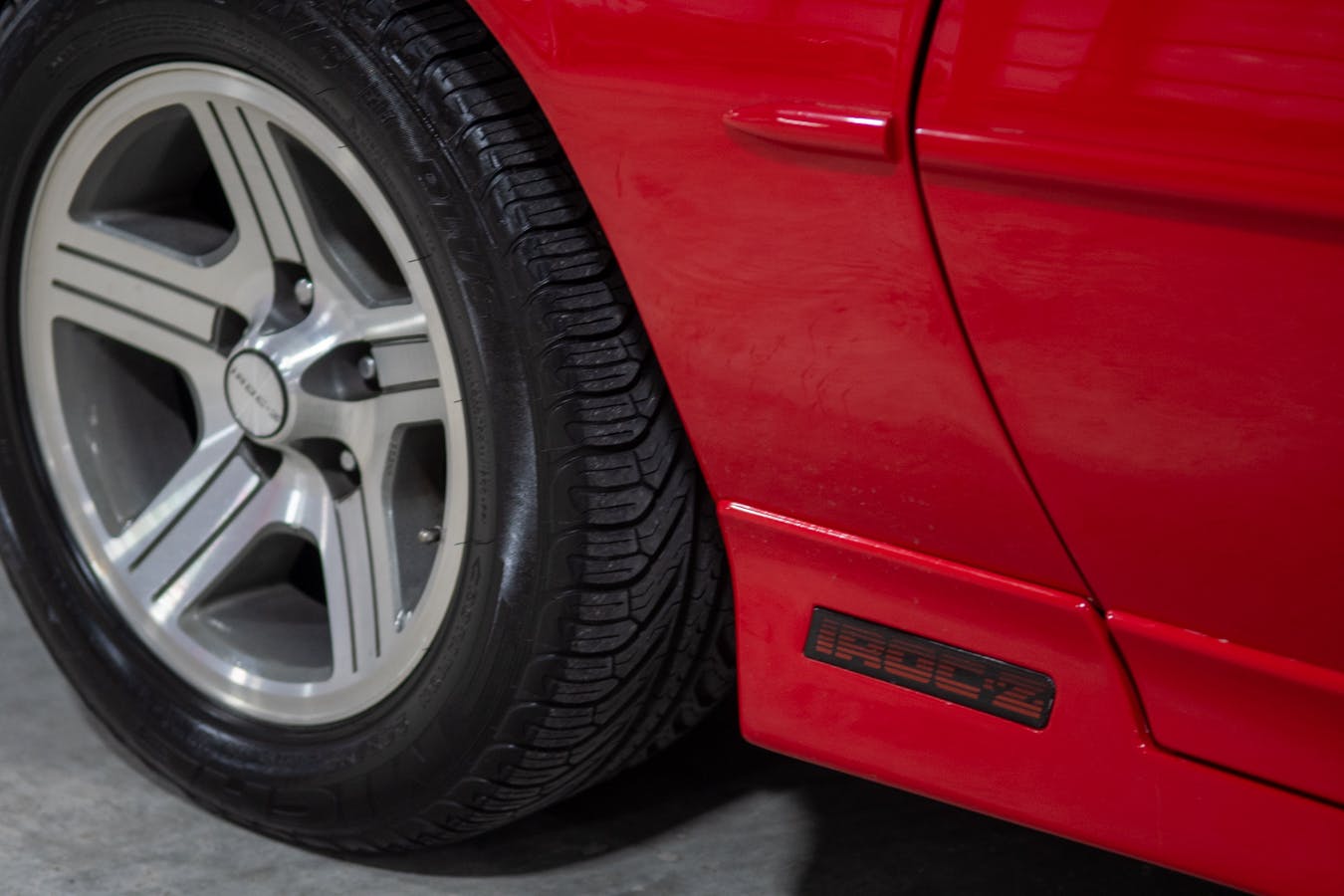
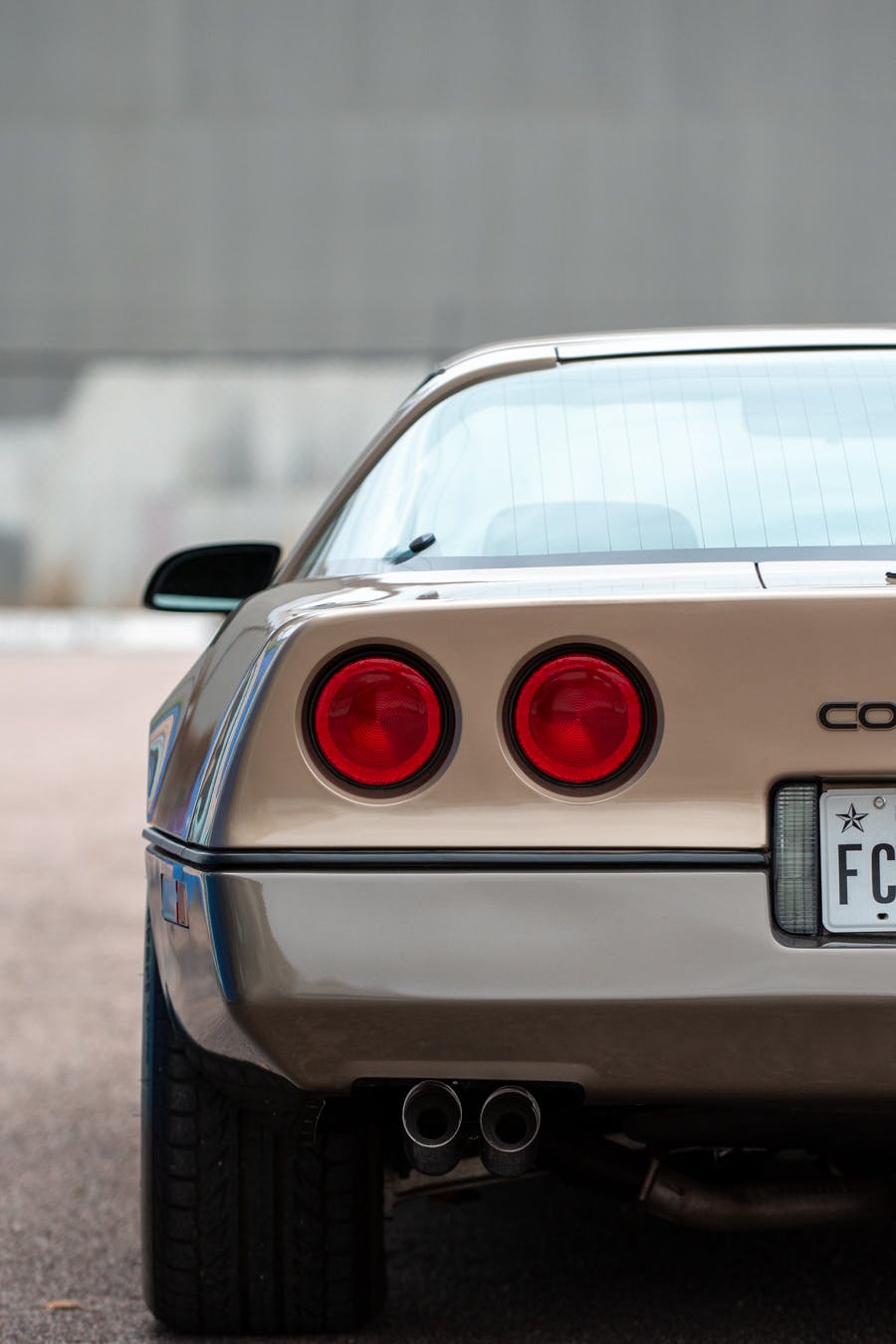
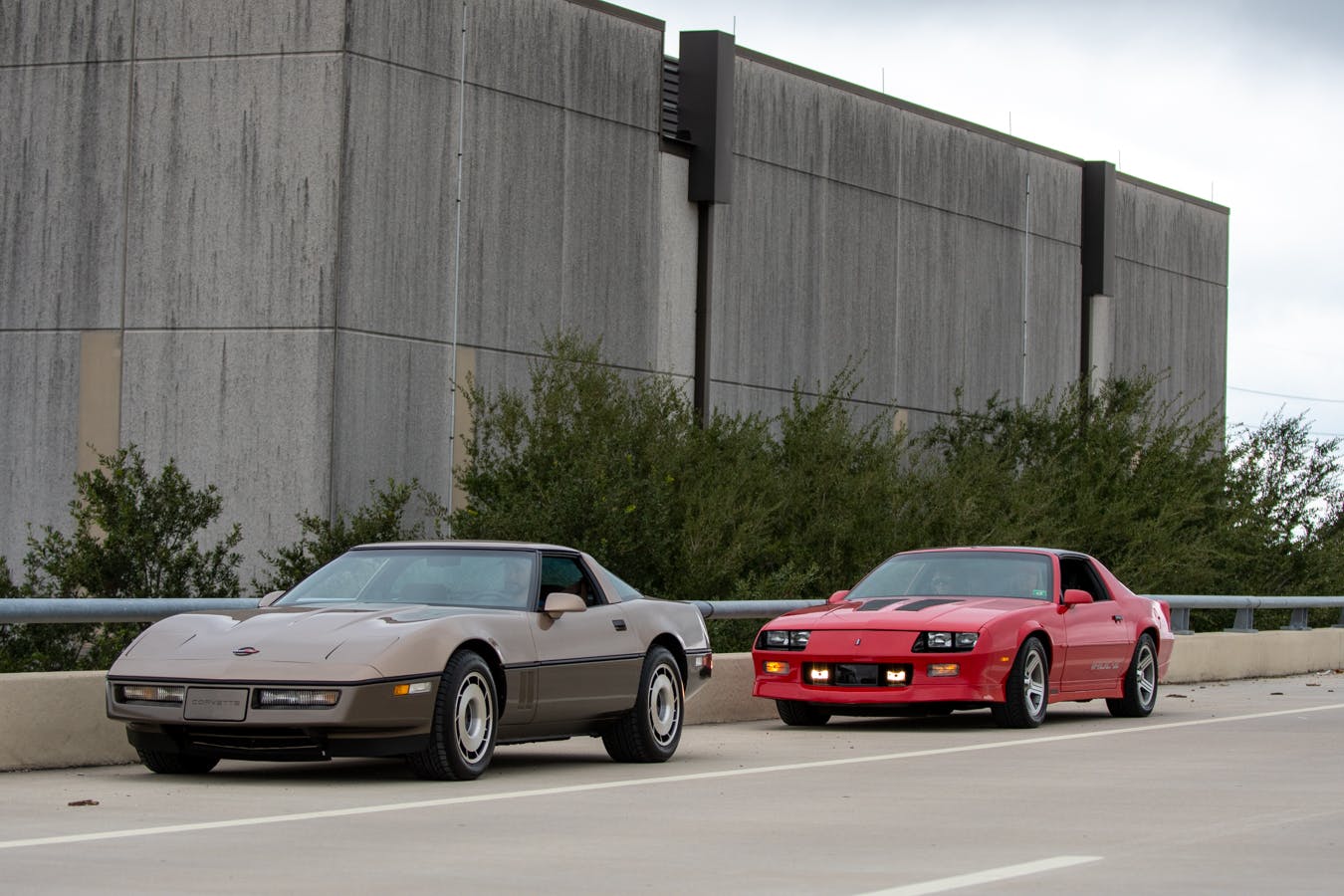
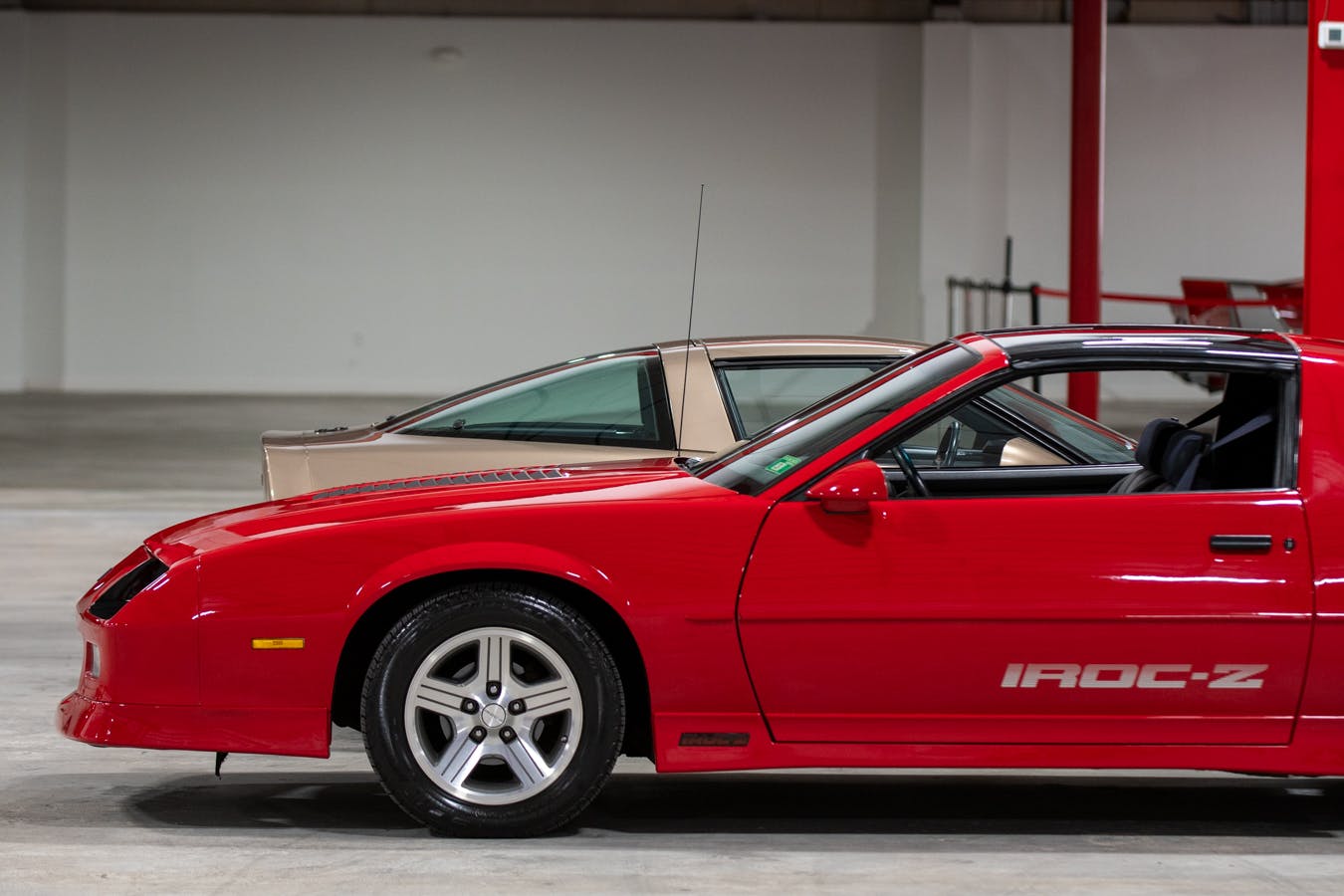
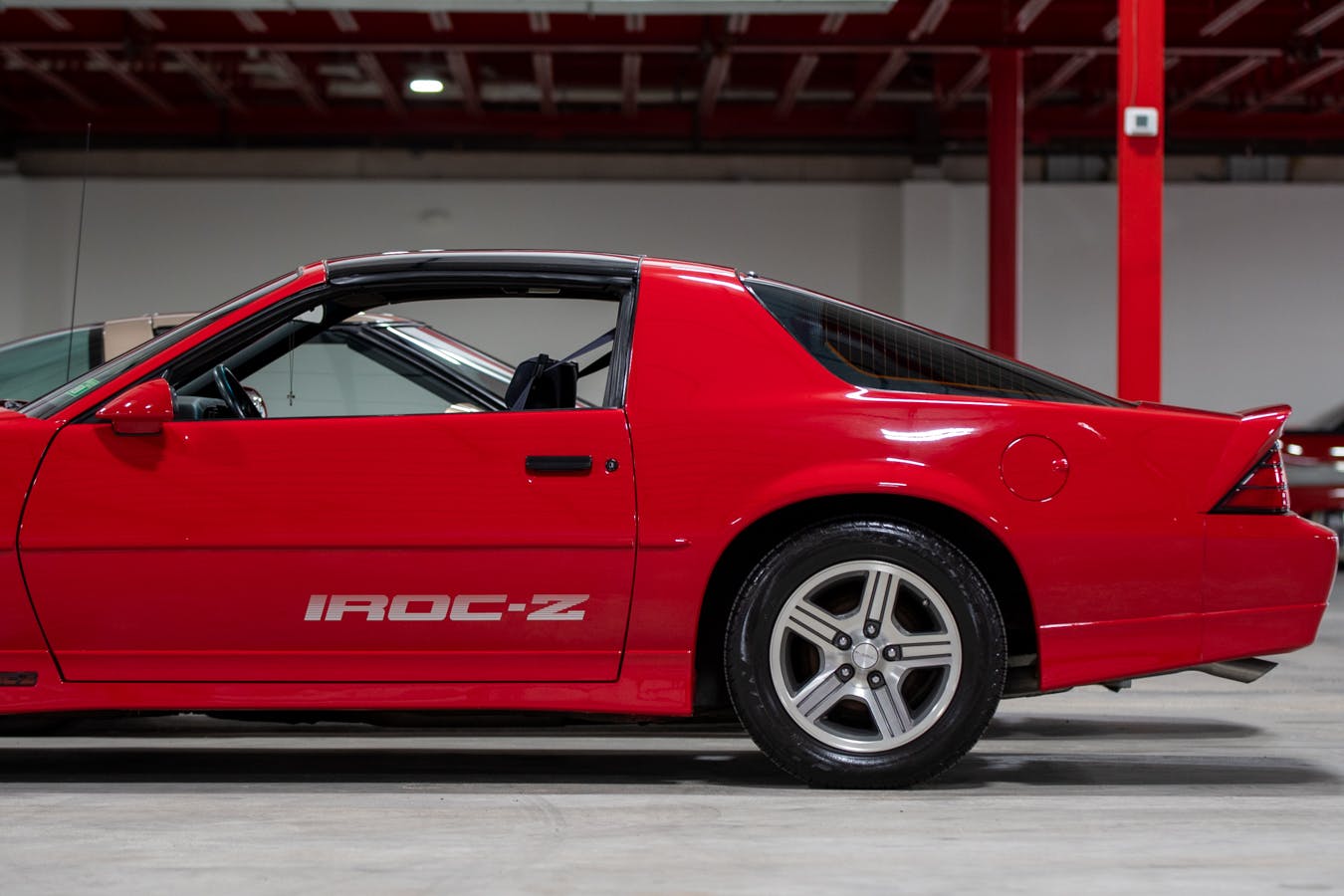























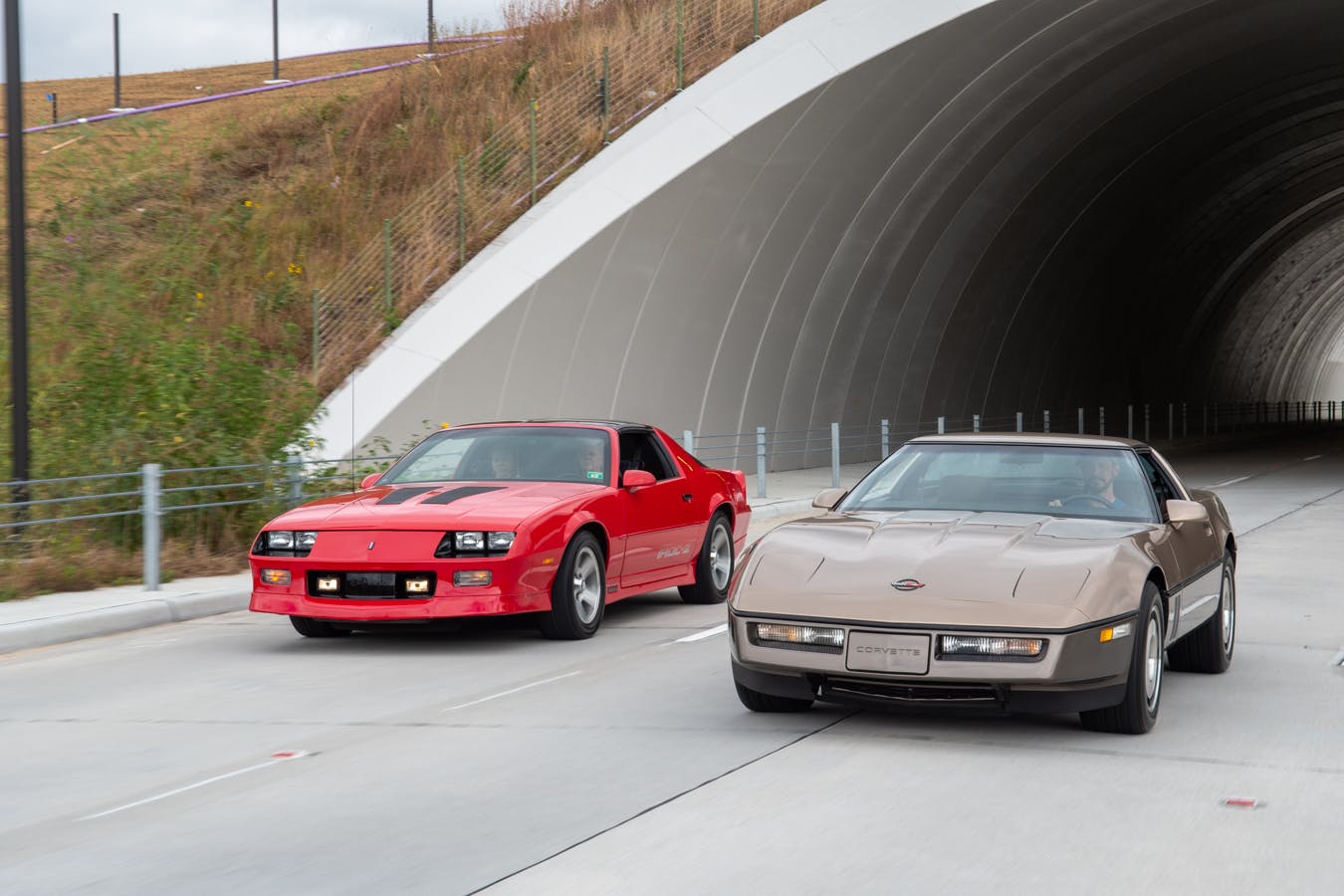
Notwithstanding the SCCA racing outcomes, the person who was buying a 1987 Porsche 944 Turbo (951) probably dismissed Corvettes. Today, it’s certainly as valuable as the IROC, in similar condition, if not more. Judging by a 33 yo 944 n/a that I know, there was nothing that seemed “plastic” about it and the build quality? the doors close(d) like it was a bank vault.
I’ve owned C4’s and 3rd and 4th Gen Camaro’s, and the Camaro isn’t in the same league
Iroc’s ,Grand Nationals, and Mustangs all suffered the same fate,most beaten to a pulp at every stoplight.Plenty of C4’s around and I was in love with them for a long time.But now I’m looking for a nice C5 as most C4 owners aren’t to realistic with what a C4 is really worth and personally I would never buy one at this point when a real nice C5 is usually below 20k. What a bargain.
GenXer comment: The C4 was dusted-off by dad’s (or grandad’s) Buick Grand National in 86 and 87. Not many people cared what the difference was on the skid pad. And the C4’s looks were as bland as a banana-sandwich. The most memorable thing I can think of about them is that Johnny Carson drove one; not nostalgia inspiring today unless you’re into the aforementioned white sneaker look. The C4 is the most forgettable Corvette ever made. Unless you enjoy recalling problematic cross-fire injection and 4 +3’s. Think about it: A Buick sedan was more exciting than a Corvette until the man that killed Buick performance went on to help wreck all of GM too. Well, GM, who remembers what other than the RWD T-type/GN was in the Buick lineup in 1986, 87,88,89,90,91,92,93,94, 95,96? The 95 and 96 Roadmaster wagon has some recognition; uh, why might that be?
Gen 3’s, GN’s, and Fox body Mustangs are where it is at in the 80’s era cars. And the RX-7. Subaru Brat maybe? Honda CRX? Toyota pickups.
Uncle Tony has entered the chat.
https://uncletonysgarage.com/2018/07/31/way-back-machine/from-buick-with-balls/
Also, I agree with you about C4 Corvettes and 4th Gen Camaros – they looked boring. They might have been great cars to drive, but you also have to look good. The first time I saw a 4th gen Camaro, I thought it was a Geo Storm.
Because “IROC-Z”. It was GM’s version of “5.0”. That’s it. Yeah the Vette, yadda, yadda. They were cool to with the tumbler headlights and KITT style dash, but GM marketing MURDERED this idea. Brilliant. And even though the mechanically similar (identical?) Pontiac Formula had “Formula” spelled it just like Chevy did, IROC-Z just sounds cooler. It still does… If you grew up in the 80s .
I bought a nice used six year old 1990 Corvette with low miles that had been treated well by the owner. It had the NEW style dash with real gauges, except the speedometer. Much better than the first “digital/graphics” display. The L98 was up to 245 horses and the torque was substantial. The car had a six speed (not the funky 4+3 overdrive manual of the early C4’s). It may have looked like an 85 model, but was a much better car. Still the “gremlins” in the Bose (junk) stereo, fuel injectors, seat lumbar pump, etc., etc. made the car a constant headache of repairs. Many repairs I did myself as finding a good C4 technician was impossible at the time (forget the dealer). After two years I had everything working, but I found the car too big for sporty driving and too uncomfortable for long haul touring. I sold it!! A Camaro with the same L98 engine, back seat, better visibility, easy to get in and out of, easier to work on, makes the Camaro more attractive.
A well written analysis from Hagerty for a change. Less personal opinion and more on actual facts. I of course had a 3rd Camaro along with a 1st generation. Also I think Andrew is right on about the lack of comfort in a C4 Corvette. Back in the day I wanted to buy a 1986 C4 convertible but the lack of comfort was too much of an issue after really wanting an 86 C4 convertible. Being that it was a convertible did make it easier to get into, but the car rattled and twisted. My 3rd generation Camaro was quite comfortable and handled very well. However I think the most important point about those 3rd gen Camaros was the very poor build quality. Over the years those Camaros just fell apart. It was quite the opposite from my 1st gen Camaro. However I still think that 3rd gen looked great. But that particular mid-80s Camaro turned me off to ever buying a GM car again. I’ve owned a Japanese 4×4 truck ever since. I think the 1986 C4 convertible was the best looking of all all Corvettes other than of course the first 1st gen Corvettes. So as far as my opinion goes I drive an older Japanese 4×4 truck from the mid 1980s. Anyway what am I supposed to know?
Phillip, you know enough!
I have 1991 original z28 66589 on engine beautiful red ttop mint get more omg’s than newer Camaros and other cars! Amazing vehicle!
I own a 1986 I rock Z Camaro with 27,000 original kilometres on it. It has the 305 engine in it. I’m just trying to figure out what a car like that might be worth if I was to sell it? Any ideas out there? Thanks
Vince, Hagerty offers valuation tools. If you insure with them you probably are already paying for access to it.
They are failing to recognize the main difference. A Camaro is a 4 seat car. If you had little kids or want to double date it’s offers so much more! The corvette is an amazing machine of you want to drive around by yourself or with a plus 1.
Hi Paul, you are absolutely right! I agree that although both are “sports cars” each serves a different kind of driver. GM or Chevrolet in particular, knew back then as well as today that there was more than one type of enthusiast market to satisfy.
A very well thought out un-biased comparison and plenty to consider about why the values between these models are currently “wonky.” Interesting to read everyone’s opinions…a great point was made about how the feeling of nostalgia influences preferring one model over the other and how it can generate demand, desirability and popularity in the market.
We have a ’96 C4 Grand Sport Coupe in our stable. I have always loved the sleek look and apart from my wife, it has the finest backside I know:) The car has a C4 rattle or two but if you go fast enough, it won’t bother you. Getting in and out is more challenging that the Camaro but once you’re in, you are in for a great time behind the wheel.
I will tell you when we have her out on the road, we get (and give) the thumbs up from and to Camaro and Corvette drivers. We belong to the Grand Sport Registry who are the most welcoming and helpful car club around. I am sure Camaro owners who are in clubs will be proud to belong to their clubs as well.
It’s always awesome to be approached by someone who wants to chat about the car be it another Vette owner, another owner of any classic or older car, a car enthusiast, the younger generation or heck, anybody!
Enjoy the drive Everyone and Merry Christmas!
My buddy’s dad had a sweet IROC in the maroon and black color scheme, and with the letters and call outs in white it was really an eye catcher. There was not a vette from the same year that was even half as visually enticing. My buddy’s dad was an electrical engineer and made good money and I asked him why he didn’t get the vette – he said people his age buy vettes b/c something happened to them – divorce, promotion, inheritance, etc. but people who buy IROCs just want a cool car.
The C4 will go around a corner.. that’s what makes it the better vehicle. I happen to have a C4 for sale and my son just got a lowish miles C5. Have to say both cars are not like comparing a Toyota to a Lexus. The Corvette is the poorish mans sports car and you can feel the poorish part in the ride.
I liked my 93 C4. It was a lot of fun hot footing it through the corners. Once I replaced the factory Optional-Spark with a MSD unit it was a very reliable ride. I drove it for 8 years and upgraded to a 22012 C6 last summer. It is my powerful daily driver/grocery getter and I have a huge grin plastered on my face whenever I drive it.